-
PDF
- Split View
-
Views
-
Cite
Cite
B. P. Kondratyev, Two-dimensional generalization of Gaussian rings and dynamics of the central regions of flat galaxies, Monthly Notices of the Royal Astronomical Society, Volume 442, Issue 2, 1 August 2014, Pages 1755–1766, https://doi.org/10.1093/mnras/stu841
Close - Share Icon Share
Abstract
In this paper, the idea of a single Gaussian elliptical ring on a circular two-dimensional ring or, in the limit, a continuous disc is generalized. Such a ring (hereafter, the R-ring) can consist of identical Keplerian elliptic orbits, of fixed a and e, uniformly portioned on the azimuth angle, or/and filled with orbits that precess around a central star or black hole. The special method of radially averaging the mass of moving bodies is developed. For this wide annulus, we compute the surface density, the two-dimensional and three-dimensional potentials, the mutual gravitational energy and the rotational energy. The surface density has two sharp peaks at the edges of the R-ring and a deep internal minimum. The Newtonian potential of the R-ring is carefully studied and the spatial equipotential surfaces are calculated. The force of attraction at the edges of the R-ring strives for infinity, and in cavity the circular orbits do not exist. The R-rings can be formed naturally in systems of bodies with a large central mass and play a dynamical role. The model is applied to the assessment of some properties of the clockwise disc in the centre of the Galaxy. For the relation of the rotational energy to the module of mutual gravitational energy, we found τ ≈ 0.29. The R-ring model offers an explanation for the existence of sharp local minima on rotation curves, which are observed in many flat galaxies. We discuss the physical sources of apsidal precession, and of the associated time-scales. We have found the relations of time-scales of apsidal precession from the supermassive black hole and the nuclear star cluster for orbits inside and outside the cluster. The apsidal precession rate of stars can largely be determined not to be a relativistic effect from the black hole and the Newtonian gravitational influence of the densest stellar cluster around the supermassive black hole.
1 INTRODUCTION
As a result, the orbit of a rotating body turns into a non-uniform elliptic ring (the wire) with the maximum density in the apocentre and the minimum in the pericentre. The difficult task of calculating the perturbations then reduces to the study of the gravitational influence of this stationary wire to the external bodies. This method avoids the time-consuming calculations on decomposition of the disturbing function in the Lagrange method.
The advantages of this method become especially obvious if the potential of the Gaussian ring is known in analytical form. However, neither Gauss nor his followers could find the potential of the wire through known elementary or transcendental functions. This difficult mathematical task was independently solved by Antonov, Nikiforov & Kholshevnikov (2008) and Kondratyev (2012). Antonov et al. proceeded from the classical approach to this problem, but in my previous work a new approach to the Gaussian ring was developed. It has been proved that the Gaussian elliptical annulus can be treated as a generalized homothetic layer with a homothetic centre placed in the active focus of an ellipse.
With the known potential of the Gaussian ring, new prospects appeared in celestial mechanics and in the dynamics of stellar systems. A perspective generalization of the Gaussian elliptic ring in a two-dimensional (2D) case was made (Kondratyev, Trubitsyna & Mukhametshina 2004). This 2D broad ring is constructed of many individual Kepler orbits and/or filled stellar orbits that precess around a central star or black hole. Here, we call this 2D disc the R-ring. In the R-ring, the orbits of the bodies moving round a large central mass are radially averaged. Such rings can be formed naturally in planetary systems (including extra-solar systems) and in the central areas of flat galaxies. Kondratyev (2007) provides additional studies of the spatial potential of R-rings.
In this paper, we eliminate some gaps in the research of the 2D and three-dimensional (3D) potentials of R-rings and we also find other characteristics of these rings, such as the mutual gravitational energy of the R-ring in the field of the central mass and the rotational energy. We apply this model to study of the actual problem of the motion of stars and gas in the vicinity of massive black hole in the centres of flat galaxies. We discuss the physical sources of apsidal precession, and of the associated time-scales. This model is applied to a study of the gravitational potential of the clockwise stellar disc in the Milky Way (Beloborodov et al. 2006). Besides, there is the intriguing question of the existence of sharp local minima on the rotation curves of many flat galaxies. The first such local features on the rotation curves of galaxies were found by Rubin & Ford (1970) and Sofue & Rubin (2001); see also Zacov & Zotov (1989). We show that the model of the R-disc helps us to understand the difficult picture presented by these phenomena. We find the relations of the time-scales of apsidal precession from the supermassive black hole (SMBH) and the nuclear star cluster (NSC) for the cases of orbits inside and outside the cluster.
2 STATEMENT OF THE PROBLEM
Because of the effects of external disturbances and the effects of the theory of relativity, the orbital ellipses do not remain closed and they will precess (Fig. 1). Then, the lower bound of a ring is determined by the conditions of the survival of stars from tidal perturbations from a black hole, and the upper bound of a ring will depend on the parameters a and e of stellar orbits.
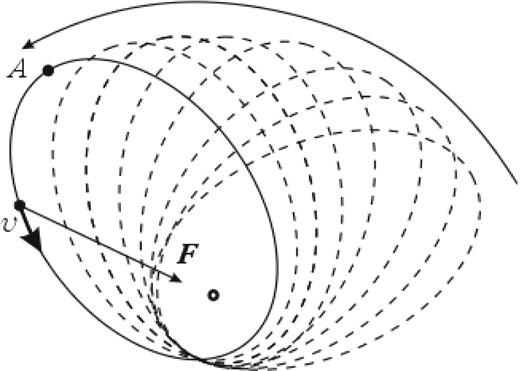
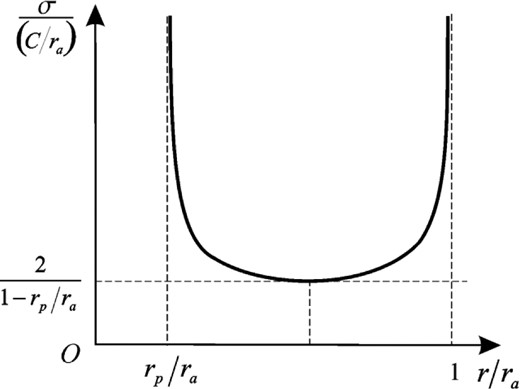
Typical surface density profile in the R-ring. The density has sharp lances at the edges and a deep internal minimum.
3 SPATIAL POTENTIAL OF THE R-RING
Calculations using equation (20) at x3 = 0 are complicated because, for example, on the internal border, the module k → 1, and then the K(1) logarithmic disperses. These difficulties have been overcome in the following way. We kept the value (x3/R1), but considered it to be very small. In such a way, we calculated the surfaces of the identical potential in the space round the R-ring.
Fig. 3 shows the meridional lines of the equal potential of the R-ring. There is the separatrix, which is similar to a lemniscate. This separatrix separates two various families of equipotentials. The absolute maximum of the potential exists at an entrance to the ring in x3 = 0, r = R1. However, it is more convenient to study the potential of the R-ring in its main plane by using equation (26).
![Lines of the equal potential for the R-ring. The potential normalized on (2/π2)φ0[1 − (R1/R2)]. The thick line shows the cross-section of the annulus. The relation of internal radius R1 to external radius R2 is 3: 5. We calculate 12 isolines (from external to internal), starting with 6.127125 up to 15.8855 with an interval of 0.887125 (Kondratyev 2007).](https://oup.silverchair-cdn.com/oup/backfile/Content_public/Journal/mnras/442/2/10.1093/mnras/stu841/2/m_stu841fig3.jpeg?Expires=1749864675&Signature=vl2NGus5yvezaPDehbOmCwc~F6sPJGgfj5m7rWnpFjglA6hJif-UWfhuRl8DmJLXrU1w7IfrLm8aJCxKsrQRrGB8mSZgCSeMl8gVy~fZc~-j70ICUj6K9NOcVHvcF1dZZ1~KKuZi4gSTF3kaxZpjTo9EJVhbHTOUWfVQQ8mOl4bRCiQ6dRO1zJqaQVVkVYOKP43DbtBB~WB4GVnh7G3QeiI9b6WA~Mop-0hDpprkGHzoiz2fXj-Te1HeLQw9En3PoC1kyObSh~vTWBE08gapDBuhX3kdhcAqUhhTP6Al7l8oW1M-CPOETH9nrusoz0Zmr7wtx21mLIS-xET8I6MazQ__&Key-Pair-Id=APKAIE5G5CRDK6RD3PGA)
Lines of the equal potential for the R-ring. The potential normalized on (2/π2)φ0[1 − (R1/R2)]. The thick line shows the cross-section of the annulus. The relation of internal radius R1 to external radius R2 is 3: 5. We calculate 12 isolines (from external to internal), starting with 6.127125 up to 15.8855 with an interval of 0.887125 (Kondratyev 2007).
4 ANNULUS POTENTIAL IN THE MAIN PLANE
Equation (32) works only at points outside the ring. At the borders and in the ring, the integrands in equation (32) have strong features that do not allow us to obtain the necessary numerical results. Therefore, we complement the calculations using equation (32) with calculations using equation (38).
5 EXAMPLES OF CALCULATING THE POTENTIAL IN THE MAIN PLANE
Using equation (28), we consider three variants of the R-ring:
a narrow ring with sizes R1 = 0.5, R2 = 0.6;
a ring with R1 = 1, R2 = 1.2 (Fig. 4 shows the normalized density as a function of x = r/R1);
a wide ring with R1 = 1, R2 = 1.5.
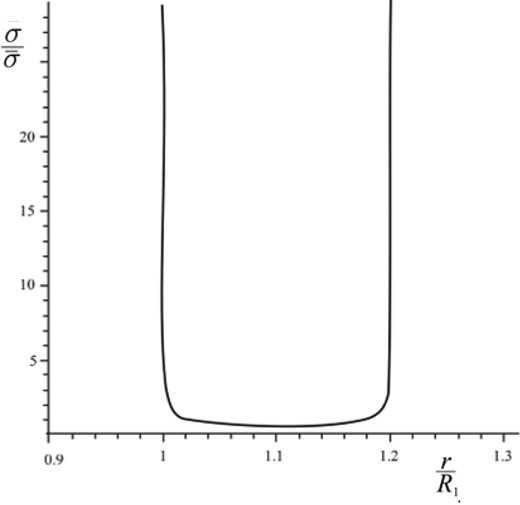
The surface density profile as a function of x = r/R1. It is clearly visible that inside the ring, the profile is almost flat and the density depends weakly on the coordinates. Here, R1 = 1 and R2 = 1.2.
For all three cases, Fig. 5 shows the distributions of the potential in the main plane. We show the general properties of such potentials. In the internal cavity of the R-ring (the interval from the centre to the inner edge R1), the potential monotonically increases, and thus especially quickly in close proximity to the internal edge. At the points where there is a substance of the ring, the behaviour of the potential sharply changes and, little by little, it begins to decrease. After the external edge of the ring, the potential begins quickly to decrease. Such behaviour of the potential in the main plane of the ring agrees fully with the calculations of the 3D potential in Fig. 3. We see a similar behaviour of the potential in Section 8, where the calculation was carried out for the existing clockwise disc in the Milky Way.
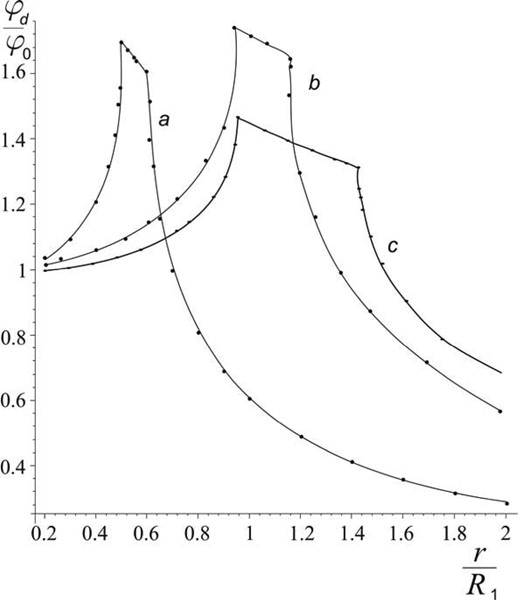
Distribution of the potential as a function of x = r/R1 for (a) R1 = 0.5, R2 = 0.6, (b) R1 = 1, R2 = 1.2 and (c) R1 = 1, R2 = 1.5. In the internal cavity of the R-ring (in the interval from the centre to the inner edge R1), the potential grows quickly enough. In the substance of the ring, the behaviour of the potential changes dramatically and it gradually begins to decrease. After the external edge of the ring, the potential begins quickly to decrease.
These calculations show that in the internal cavity of the R-ring (in the interval from the centre to the inner edge R1), the potential monotonically increases. This leads to the fact that in this range the gas acts as the gravitational force, which is directed from the centre of the ring. If the R-ring is placed in the potential of the spherical (or spheroidal) bulge, the R-ring's own gravitational field leads to the local fall of the gas velocity rotation at r = R1. Therefore, for a certain combination of parameters of the ring and bulge (or the black hole), the gravitational properties of the R-ring can become a physical cause, which explains the presence of additional local minima on the rotation curves of flat galaxies.
6 SUPERPOSITION OF THE GRAVITATIONAL FIELDS ‘R-RING + CENTRAL POINT MASS’ AND ‘R-RING + SPHERICAL BULGE’
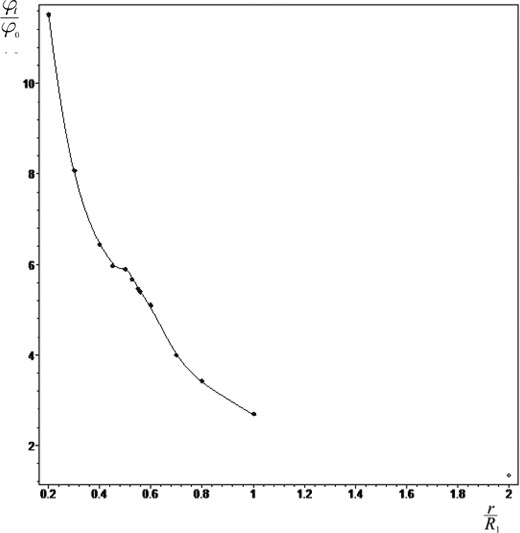
Total potential ‘central point mass M0 + R-disc’ as a function of r/R1. For the calculations, we have taken the following model parameters: ring sizes R1 = 0.5 and R2 = 0.6 and the binding parameter (GM0/R1φ0) = 2.1. The influence of the R-ring is shown by the fact that near the inner boundary of the ring there is a narrow interval with a flattening (or plateau) of the potential graph, which means that there is a local decrease of the velocity rotation of gas.
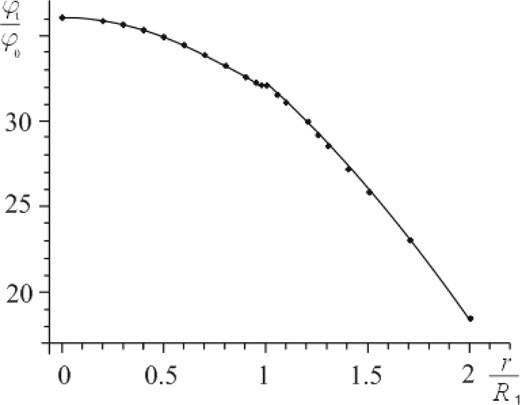
Total potential of the system ‘inhomogeneous spherical bulge +R-ring’ as a function of r/R1. For the calculations, we have taken the following model parameters: ring sizes R1 = 1 and R2 = 1.2 and the binding parameter (GM0/R1φ0) = 2.1. The plateau on this curve occurs when entering the ring inside.
7 ROTATIONAL CURVES FOR THE CIRCULAR MOTION OF GAS IN THE GRAVITATIONAL FIELD ‘R-RING + BULGE’
As mentioned in the introduction, many rotation curves of flat galaxies have additional local minima. Fig. 8 shows a typical rotation curve with an additional local minimum.
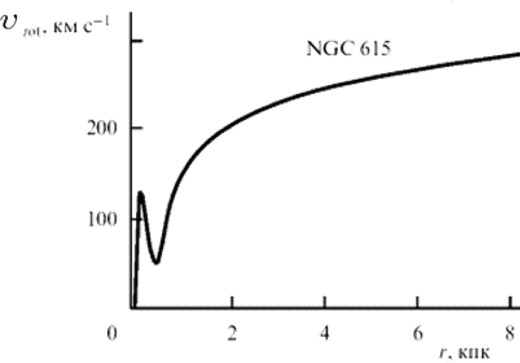
Rotation curve of the galaxy NGC 615 as a typical example of the profile velocity rotation of flat galaxies (Khoperskof & Friedman 2011).
Such features on the rotation curves are successfully explained by the R-ring model.
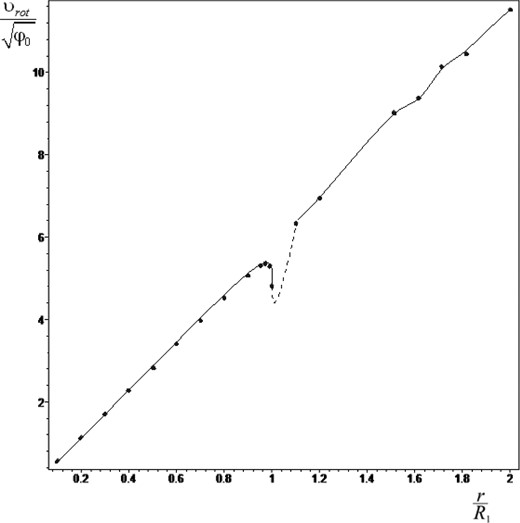
Rotation velocity profile in the potential ‘inhomogeneous spherical bulge + R-ring’ as a function of r/R1. The parameters are R1 = 1, R2 = 1.5, x3 = 0.001, R1/R = 3 and k1 = 33. The sharp local minimum appears at an entrance to the R-ring. There is also some evidence of a secondary minimum at an exit from the ring.
By comparing Figs 8 and 9, we can see that observations are in good agreement with calculations for the R-ring model.
Thus, at an entrance to the R-ring, there is clearly a certain minimum of the velocity rotation.
8 APPLICATION TO THE CLOCKWISE DISC AND APSIDAL PRECESSION
Here, we neglect the fact that the disc is blurred on the z-coordinate. We calculate the Newtonian potential in the main plane of the clockwise interval disc using equation (28). The results are shown in Fig. 10.
The cavity inside the ring is relatively narrow (0 < r ≤ 1 arcsec), but the inner edge is sharp, in agreement with the observations. The potential in the cavity monotonically increases. Then, with regards to the disc, the potential begins to decrease fluently, and the fall becomes steeper after the external edge of the disc.
The potential of the clockwise disc in equation (50) is still given by equation (28). Fig. 11 shows the total potential calculated using equation (50). It is important to note that because the connective parameter (51) is large, the SMBH in the Milky Way suppresses the gravitation of the clockwise disc and the plateau of this curve is quite tiny (cf. Fig. 6).
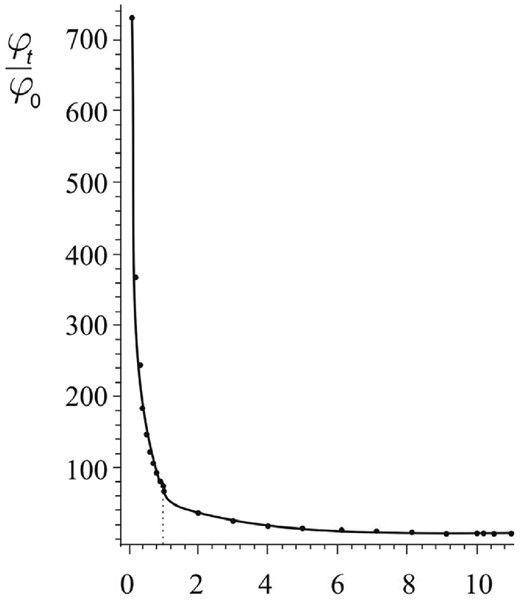
Total potential ‘central point mass MSMBH + clockwise disc’ as a function of r/R1. The calculation was carried out using equation (50) with the real value of the connective parameter η = 73. The vertical dotted line marks a tiny plateau on this curve at the entrance to the ring.
For the SMBH in the Galaxy, we find the very large value Tprec ∼ 5 × 108 yr, or N• ∼ 105. Even for stars with semimajor axes of the orbit a ≈ R1, the time precession remains large, Tprec ∼ 7 × 106 yr. Only for the star S2 nearest to the black hole (Gualandris, Gillessen & Merritt 2010) with semimajor axis a ≈ 0.119 arcsec and period equal to Tprec ≈ 26 593 yr, we do find N• ∼ 1.75 × 103.
However, there is also a second source of precession, which should be considered. This is because, in the central parsec of the Milky Way, in addition to the SMBH, there is a NSC of B-stars with mass M* ∼ 106 M⊙ and the density distribution ρ ∼ c/r1.8 (Schödel et al. 2009; Merritt 2013). This cluster of stars is the source of the mass precession, because of the distributed mass around the SMBH. There are two options.
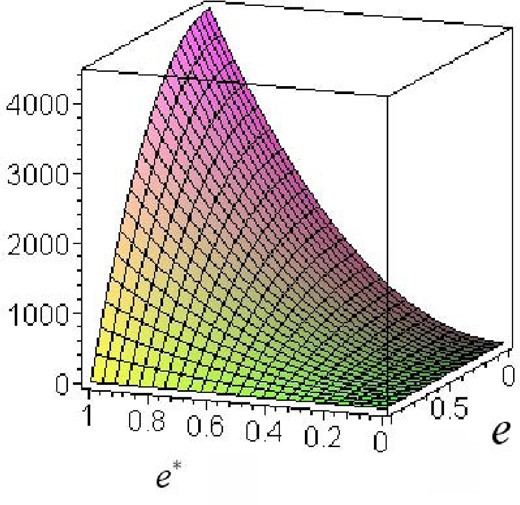
Ratio of time-scales of the apsidal precession of Keplerian orbits in the clockwise disc in the central parsec of the Milky Way. The second case is for an apsidal precession of a star, when its orbit is outside the NSC. Calculations were carried out using equation (67).
From the physical point of view, the main features of the relation time-scales (67) are: (i) the strong dependence of the ratio on the shape of the cluster and from the value of eccentricity of the orbit of a trial star; (ii) the large value of the coefficient 4.4 × 103. Acceptable values for the ratio of time-scales (67) are still quite large in favour of the second type of apsidal precession.
9 SUMMARY
We have considered the structure and 3D potential of the broad material ring (the R-ring), which consists of identical Kepler elliptic orbits, of fixed a and e, uniformly portioned on the azimuth angle. The density distribution in such rings is the result of 2D radially averaging of the mass of moving bodies. In principle, R-rings can also be filled with stellar orbits that precess around a star or black hole (rosette-like orbits). However, as calculations show, the time-scales associated with apsidal precession round a black hole for real stars in the clockwise disc are extremely large.
The potential of R-rings cannot be represented in analytical form. This circumstance complicates the calculation of the potential and the gravitational force of this ring. Therefore, it is necessary to unite various equations to calculate the potential of the R-ring. In particular, this allows us to calculate the spatial equipotential surfaces and to obtain the mutual gravitational energy of the R-ring in the field of the central mass M0. The rotational energy of the stars of the ring was obtained, which is useful for investigating a stability configuration.
The R-rings can be formed in a natural way in dynamical systems with a large central mass. In galaxies, such R-rings are created by radially averaging the orbits of stars, which move around a massive black hole and in the NSC. Therefore, the use of R-ring models to study some questions in the dynamics of galaxies is quite justified. For example, in the framework of the model, we have calculated the ratio Mr/Mb ≥ 5 × 10−3, which is the lower limit for the existence of secondary maxima on the rotation curve. For the clockwise stellar disc in the Milky Way, we calculate its potential, the total potential of this disc in the field of the point central mass MSMBH and the rotational energy of stars. For the relation of the rotational energy to the module of mutual gravitational energy, we find τ ≈ 0.29. The fact that this value τ exceeds the known criterion τ ≈ 0.14 (Ostriker & Peebles 1973) does not indicate the instability of this disc. In fact, the mass of the clockwise disc is known only very approximately and, besides, it is necessary to consider also the gravitational energy of the disc.
In spite of the huge mass of the black hole, the apsidal precession time of only one SMBH for stars in the real clockwise disc is extremely large. However, there is another source of apsidal precession, which is potentially even more important. This cluster of stars is the source of mass precession as a result of the distributed mass around the SMBH.
It is necessary to distinguish the apsidal precession for internal and external orbits. These two cases have different dynamic interpretations. For the case of inner orbits (Merritt 2013), the form of the cluster does not play a dominant role and a basic contribution to the effect brings in the spherical case. Taking into account the flattening of the cluster gives only small amendments to the main effect. In addition, the direction of motion of the apsidal line is the inverse. Because the relation of time-scales is equal to |ε*|/ε• ≈ 104, this mass precession is more important than the relativistic effect.
However, there is also a second case that describes the apsidal precession of trial stars, when their orbits are outside the NSC. For the case of external orbits, the form of the cluster plays an important role, because the rate of precession is proportional to the square of the eccentricity e*2 of the meridian section of the oblate spheroid. In this case, the mass precession is more important than the relativistic effect. We note that the direction of rotation of the apsidal line here, as in the relativistic case, coincides with the direction of the orbital motion of the star.
It is also possible, apparently, that there is a mixed case, when the orbits of trial stars are partly beyond the boundary cluster.
Importantly, in both cases, the apsidal precession rate of trial stars in the central parsec in the Milky Way can largely be determined not to be a relativistic effect from the black hole, and the Newtonian gravitational influence of the densest stellar cluster around the SMBH.
In this paper we have considered the R-disc with one only set of a and e. The simple model provides an accurate calculation of some characteristics of real objects. However, in the future, we should create a superposition of R-discs. Such a complex disc created from elementary discs will have other profiles of density and potential and a wider range of applications.
I am very grateful to the referee for providing stimulating recommendations that have improved this work and to N. G. Trubitsyna for technical assistance.




